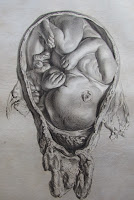Puerperal Fever

As advances in medicine are made, it is sometimes easy to forget about illnesses or infections that once plagued people on a regular basis. One such infection is puerperal fever, or as it was more commonly known "childbed fever." This is a bacterial infection of the birth canal which can be contracted by a woman during childbirth. If it is left untreated, it often leads to septicaemia or peritonitis which can be fatal. In the 18
th and 19
th centuries, puerperal fever was the leading cause of maternal mortality and it was an extremely common occurrence in women who had just given birth.
 |
| Dr Ignaz Semmelweis |
A major cause of puerperal fever was in many instances, doctors themselves, who either did not know about, or chose not to believe in the existence of germs and bacteria. Thus, many of them did not wash their hands before attending a woman in labour. There was also a social element to this in that doctors were perceived as gentleman and a gentleman always had clean hands. Although numerous doctors spoke out and advocated hygienic practices such as washing hands with antiseptic, they were ignored. One such doctor; Ignaz Semmelweis (1818-1865) was so ridiculed that he was fired from his job, suffered a nervous breakdown and ended his days in a psychiatric institution.
In Ireland, as in every other country, the rates of puerperal fever were extremely high and numerous papers on outbreaks which occurred and on the nature of puerperal fever were published by various physicians such as Alfred M'Clintock (1821-1881), John Brenan (1768-1830) and Fleetwood Churchill (1808-1878).
 |
| Robert Collins |
One physician Robert Collins (1800-1868) who became Master of the Rotunda Hospital in 1826, was a pioneer in the fight against puerperal fever. Suspecting that bad hygiene and inadequate ventilation were the main causes of the infection, Collins instituted a rigorous policy of disinfection and cleanliness of both the hospital and in particular the labour wards. Under his system, wards were used in rotation as labour wards and patients were forbidden to move between wards. Once the ward was full, no more patients were admitted until all patients had been discharged. Once empty, the ward was thoroughly cleaned and disinfected and the floor treated with chloride of lime. These policies, amongst others he set up were incredibly successful, to the point that there were no cases of maternal death from puerperal fever during the last four years of his tenure in the hospital.
Collin's work came to the attention of other doctors and the ill-fated Semmelweis was deeply influenced by his system and his work on the nature of the infection. Unfortunately, Collin's policies were not as rigorously enforced after his departure. The Annual Reports of the Board of Superintendence for Dublin Hospitals from 1858-1868 show that in both the Rotunda and the Coombe, puerperal fever was still the main cause of maternal death, accounting for almost half of the deaths which occurred.
 |
| Rotunda Hospital, Dublin |
Today, the instances of puerperal fever in the developed world have been reduced dramatically due to good hygiene practice and deaths have been reduced due to the invention of antibiotics. However, even in first world countries it is still a significant risk factor in childbirth and remains a major cause of maternal mortality today.
Ruth Talbot,
Library Intern